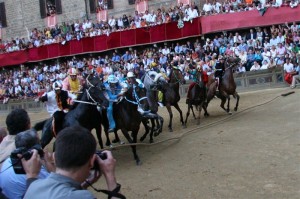My reflections in this short blog are concerned with all of us, in our present era, in England – we might do well to learn to commit ourselves to what we think God wants of us in life. Only in this way will we learn the secret of how to find contentment and meaning, and so find that elusive “happiness and fulfilment” in life. It depends on our ability to remain committed, a task that seems not so easy in modern England.
Monday each week is a good day for me as it is my ‘day off’, away from Leyland, and there is time to sit, meditate and pray – at peace and at my ease.
Last Monday was the feast of St. Catherine of Siena, a much loved saint and Doctor of the Church. I recall having been to Siena when still a young boy, with my brother, Tim – young boys at the innocent and tender ages of 10 and 12 – together with my beloved parents. I still have memories of seeing the house where St. Catherine lived, the square nearby, where they have horse-racing – with bare-backed riders – dating back to the 17th. Century, but with even earlier, medieval, origins. For me, it was so hard to imagine how racing could be possible, as the square was slippery with the flags and cobbles, but they race twice each year, in July and August, right there, in the midst of the City of Siena. What memories! St. Catherine was a great lady, but the City where she lived, was like many in Italy, with café’s selling all kinds of drinks, the smell of garlic, the heat beating down. It had been a long and hot car journey getting there, and we were two small boys, tired, hot, disgruntled and, truth be told, rather bored. Only much later, last Monday to be precise, could I intuit what a great person St. Catherine was, and how truly beautiful, and historical, is the medieval City of Siena.
 |
Start of the famous race Il Palio: thousands of people come to watch in July and August
I read in the breviary the following words written by St Catherine. I was aware that she was just a comparatively young girl when she died, yet what she wrote astonished me greatly:
O eternal Trinity, God, you are an abyss, a deep sea; you have given yourself to me – what greater good could you give? You are a fire, ever burning and never consumed, consuming in your heat all the self-love of the soul, taking away all coldness. By your light you enlighten our minds, as by your light you have brought me to know your truth.
In this light I know you, and I picture you to myself as the supreme good, the good beyond all good, the blessed good, the incomprehensible good, the inestimable good, beauty beyond all beauty, wisdom beyond all wisdom.
Could I have written those words in my twenties or early thirties? Quite impossible! So what made it possible for St. Catherine? I did a little research into her life and discovered some astonishing things – things that took me into another world, another culture, another set of values; perhaps we can learn from them.
“She was a twin, born prematurely, and the 22nd child of her mother, Lapa, who gave birth to 25 children and lived to be 89 years old, long enough to see Catherine buried! Catherine’s twin sister, Giovanna, died, as did half her brothers and sisters, in infancy. This was the year 1347, and the ‘Black Death’ had ravaged the area. Catherine had her first vision of Jesus when she was five or six, and Jesus had smiled at her. She made a vow of chastity, for herself, at the age of seven. A little later, her elder sister, Bonaventura, died in childbirth, and her father, Giacomo, wanted Catherine to take Bonaventura’s husband – her own brother-in-law – as her husband. Catherine, then sixteen and utterly opposed to this proposal, undertook a strict fast to demonstrate her abhorrence – a technique she had learnt from her own now dead sister, Bonaventura, who had been treated badly by her husband, and had found fasting helpful in sorting out her relationship issues. Catherine even cut her long hair short so as to make herself less attractive as a potential bride.
Catherine would later advise her confessor, (and biographer), the Blessed Raymond of Capua O.P., (who went on to become Master General of the Dominican Order), to do during times of trouble what she did then as a teenager: “Build a cell inside your mind, from which you can never flee.” In this ‘inner cell’ she made her father into a representation of Christ, her mother, Lapa, into the Blessed Virgin Mary, and her brothers into the Apostles, so that serving them, humbly, became an opportunity for spiritual growth. In this way, the greater the suffering, the larger her triumph became. Eventually, her father gave up and permitted her to live as she pleased.”
 |
St. Catherine, cutting off her long hair as a precaution against being forced to marry
Such single-minded determination is amazing, and yet I do not see why it should not happen in our own age. To be honest, it would have been impossible, to vow myself to chastity, at the age of seven, and stick by such a vow. I have, by God’s grace, followed the call to be a monk, from the age of eighteen; similarly, I hope and pray, with God’s help, to remain faithful in this calling, until death. Generally speaking, it would seem not easy, for young people in England, today, to make such commitments, however.
Catherine, I discovered, died at the age of thirty three. In her short life, she was the adviser of Popes and leaders of all sorts, and involved in trying to heal the sad ‘divided’ Church situation of her times, a time when the dichotomy involving France, Italy and the Papacy threatened the very existence of the Church, itself; she was then, and still is, an inspiration to people all over the world and has been so ever since her death. However, she did not set out to be an inspiration for others; that was not her aim; just to follow God, and his will, was her way.
But my story does not quite end there. The precarious nature of life in the 14th Century – even before – and afterwards – often devolving, together, with large families, goes on until today, even in England. I have in mind Nora, a parishioner, who was one of 9 siblings, and I visited her on Tuesday, in her Leyland nursing home. Her husband, John, was one of 11 siblings. They lived around the corner from each other, in two different Preston streets. The houses had three bedrooms – for families of 9 and 11 – I ask you! What an experience in which to grow up and flourish! What a completely different set of values, culture, hopes and dreams, that we – of a certain age – have experienced in our own life time. Nora told me, “everyone was poor and we were used to it. It was very different from today: but then, perhaps, better!” She knew her husband, John, from her Primary School days, in Preston, and was happily married till John died some 9 years ago. She, too, was able to make a commitment and stick to it. John used to lecture at Blackburn College, where there were many foreign students. She told me that, one day, John came home and said: “I am invited to go and teach in Africa; will you come with me?” Nora said nothing, but went upstairs, and got her empty suitcase, leaving it at the front door. “I am ready now”, she said. Both left good jobs for this, their new adventure, which took them to different countries and lasted until they returned to the UK, to settle in Leyland after John’s retirement. Now I know that this is not quite the same as in St. Catherine’s case, but the commitment, the simple response to God’s call, and a fulfilled and happy life, are all similar.
What are the lessons for us? Let us draw our own conclusions, but let me say that, in today’s world, when so many people do not keep to the commitments they have made – whether married people, priests or religious, we could all learn from example. Furthermore, there are many who do find it so very hard to make a real commitment, in life, in the first place; they cannot decide what their pathway is, and will sometimes for instance, “have a partner, and fail to marry for many years, if at all”. Young and old are the same: they dabble here, and there, in this, and that, and do not come out clearly, one way or another. The old English proverb puts it well: “they want both, their cake and eat it”. But where does that leave all who need inspiration and guidance in life?
Always remember – anyone who stumbles across this blog – that God cannot but love each one of us, always, even in disconnected circumstances. He will hold us in the palm of his hand and teach us, lead us, and do so through the events that happen to us, as long as we turn to him.
Father Jonathan
